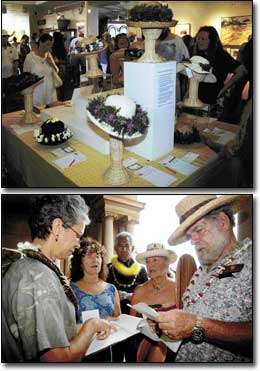“Show-quality” leis draw hundreds of residents and visitors to the 24th annual May Day Festival and Lei Contest at the Kaua‘i Museum Saturday.
Eighty entries of colorful, fragrant leis that were intricately weaved with thousands of flowers like gardenias, bougainvillea and orchids were put on exhibit.
Museum director Carol Lovell said the leis were made by professional and nonprofessional lei-makers from Kaua‘i and Ni‘ihau, and that the creations could easily rival leis found in any state competition, adding “they (leis on display yesterday) sure are, and then some.”
The event, sponsored by the Kaua‘i Museum, marked the fourth or fifth consecutive year in which lei-makers were instructed not to use native plants, as a way to preserve them, museum representatives said.
“We have taken mokihana (plants) out specifically, because we don’t want people going into the forest for picking and gathering, Lovell said. “We asked people not to use maile (plants) for the same reason.”
For the first time in the 24 years the contest has been held, the “most typically Hawaiian lei” category was dropped from the competition.
Peter Dease, a trustee on the board of the Kaua‘i Museum and one of 21 judges for the event, was heartened to see lei-makers use seagrape, in some cases, in place of maile or mokihana plants.
“We are trying to preserve native plants, the ones that are endangered,” he said.
Heu‘ionalani Meph Wyeth, one of the judges, said the decision by lei-makers not to use native plants for their creations will help preserve Hawai‘i’s precious resources.
“Last year was the Year of the Native Forest. The idea was to protect forested places,” she said. “People (lei-making contestants) got creative without using the native plants. That is a good thing.”
Organizers of the contest had earlier asked contestants to use flowers and ferns they had grown for their contest entries.
Leis this year boasted foliage that included gardenias, crown flowers, stephanotis, papalai ferns and white bozo, orchids, green rose, which emitted the scent of pepper.
Mayor Bryan Baptiste, who was one of the judges, said leis are a special creation that come from the soul and the heart of people.
“It (the making of leis) mixes creativity with their minds, mixes the essence of the emotions, and mixes hand work and stamina to it together,” he said. “The final product embodies the individual who made the lei, and is a representation of their gift to Kaua‘i for May Day. It is a great thing.”
Dease was enamored of a lei consisting of thousands of orange ohai ali‘i and ilima flowers made by Lola Bukoski, winner of the Ginger Alexander Award.
“They had to pick them (the flowers) all at once. They had to pick so many plants to get this many ilimas. Incredible workmanship,” Dease said of the creation by Bukoski. “They must have finished (the lei) at 4 this morning (Saturday).”
Other judges included Paul Douglass, Roberta Wallace and Stacy Sproat, all trustees of the museum, and were instructed to pick a winner only for the Trustee’s Award lei category.
The Ginger Alexander award was in memory of Alexander, a former director of the Kaua‘i Museum who drowned during a heavy storm in Anahola in December 1991.
Tim Dela Vega, a judge and president of the board of trustees of the Kauai Museum, said lei-making is an art and that leis, beaus the life span of flowers is short, are precious.
“In a sense, this is pure art. Paintings will last a hundred years, or thousands of years,” Dela Vega said. “This (lei) will last a day or two and they are gone, They are more fragile, more precious.”
Maile Baird, a professional lei-maker with 40 years of experience, said Irmalee Pomroy’s entry was of exception quality, and selected the lei as the winner in the Peace Award category. The creation included pansies and papalai ferns and used a hao chord to tie both ends of the lei together.
“It flows nicely, The essence is very peaceful, the colors (purple flowers included) are really soothing,” she said. “It stood out for me.”
Sane Morita, a Lihu‘e resident and a volunteer with the Kaua‘i Museum, said she has attend the lei-contest for the past tens, and it seems the lei creations are more “beautiful and creative” each year.
“I always marvel at the creativity of the leis,” Morita said. “It never fails to impress me about how many more people are getting involved in making these beautiful leis, and keeping the tradition of the lei day alive.”
Thelma Blake, the aunt of former Kaua‘i County Attorney Hartwell Blake, was among more than dozen kupuna who attended the event.
Seated in a chair inside of the museum, she smiled as she scanned the exhibits of leis, adding ” what is here is very beautiful.”
She particularly liked the lei hats. Blake said she made hats like them as a girl attending school on Kaua‘i in the 1930s.
Dela Vega said a day set aside to celebrate the art of lei-making honors a Hawaiian tradition that goes back hundreds of years and a Polynesian tradition that goes back thousands of years.
“Lei Day is one of the most honored and treasured Kaua‘i traditions,” Dela Vega said. “To me, it is an honor to be part of a tradition that literally goes back to millennium.
Dela Vega said Hawai‘i residents can thank Don Blanding for lei day. In 1929, Blanding, an author, came up with the idea for an official lei day in Hawai‘i.
The contest featured eight main categories and 12 other lei categories, all of which were based on colors of flowers or type of flowers used.
Staff writer Lester Chang can be reached at 245-3681 (ext. 225) and lchang@pulitzer.net





